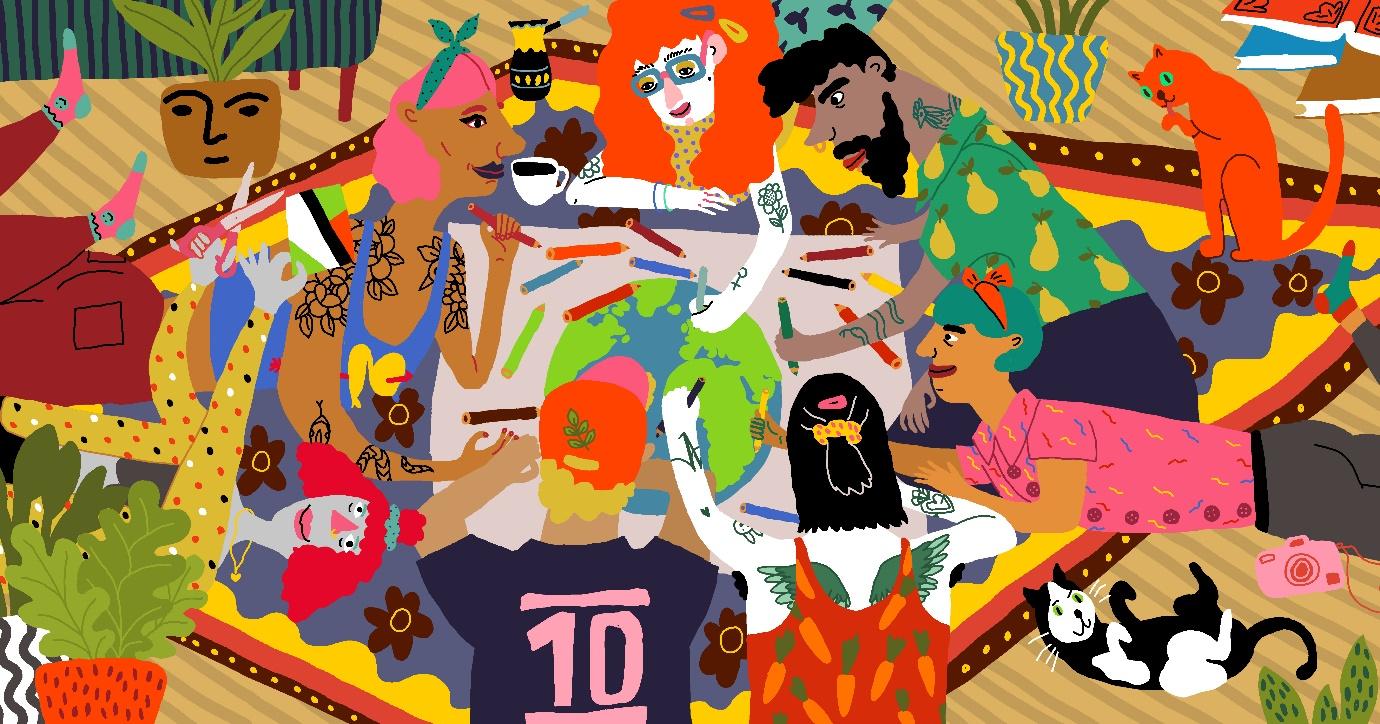Artwork by Ezra W. Smith
Young people are at the forefront of current climate activism all over the world, demanding that individuals and governments take action against climate change and value young people’s future. But how can we better value the diversity of young people participating in climate action, and recognise the long tradition of LGBTQ+ people valuing nature and the environment?
The relationship between queerness and value is fraught, because queerness has so often been defined precisely as that which is not valuable within a society that is structured around heteronormativity and reproduction as primary values. Historically, some LGBTQ+ people have tried to claim value by highlighting their contributions to society. In Anders als die Andern (Different from the Others), a German silent film from 1919, the sexologist and gay rights activist Magnus Hirschfeld collaborates with filmmaker Richard Oswald to call for the greater acceptance of gay men. In the film, we see a long line of noble gay men from history, including kings, writers, and artists. The film seems to say: as gay men, we too are contributing to society. This kind of respectability politics, however, tries to find a place for queer value in a society that is already structured around the exclusion of queer life and where queerness is bound to remain less valuable unless it tries to imitate heteronormative ideals. If we truly want to value queer futures, we need to be attentive to existing exclusions of LGBTQ+ people in thinking about the climate crisis, and we need to embrace the focus on queer futures as an opportunity to fundamentally rethink future society and its values for all.
At present, LGBTQ+ people are specifically affected by the climate crisis. Queer and trans people, especially queer and trans people of colour, tend to experience heightened suffering as a result of natural disasters resulting from climate change. In the UK, about 24% of homeless youth are LGBTQ+, and particularly vulnerable to weather events caused by climate change. LGBTQ+ people often face discrimination when accessing support, for example in shelters, and experience difficulties when trying to cross borders to escape weather events, conflicts, or disasters.
Young LGBTQ+ activists are also deeply invested in care for the environment and in taking action against climate change. Through running workshops with young LGBTQ+ people in the South West of the UK, we found that these young people have developed strengths in building communities and the ability to care for each other. Caring for their local environment is part of LGBTQ+ young people’s extraordinary ability to create community, home and belonging. The role of LGBTQ+ young people in climate activism indicates a high degree of empowerment and connection with others, particularly highlighting the ways that queer youth are engaged with wide-ranging social issues.
Queer people in the past have played a central role in rethinking the value of nature. Lesbian sexologist Edith Ellis (1861-1916) wrote about Cornish seaweeds and seascapes, reflecting her bond with a changing natural world. Gay rights campaigner Edward Carpenter (1844-1929) promoted vegetarianism and farming as part of a healthy and sustainable lifestyle. The collection of sand samples by gay literary activist Ivor Treby (1933-2012) resonates with the queer eco-poet Caleb Parker, elected as Bristol City Poet for 2020-22. These histories are representative of the longstanding presence of LGBTQ+ people in discussions about nature and environments. Recentering this queer environmental history as central to environmental thought can empower LGBTQ+ youths to take forward climate action.
Questions
- To what extent are LGBTQ+ voices/experiences valued in current climate activism and thinking around the Anthropocene? What possible imagined futures open up when we value LBGTQ+ experiences and world-making, past and present?
- Who has the capacity and the privilege to value environments and futures?
- What is the importance of communities in creating value in the Anthropocene?
- How and what can we learn from the past to value queer futures?
Readings
Behal, Anuj. (2021). ‘How Climate Change Is Affecting the LGBTQIA+ Community’. Down to Earth, 11 January, https://www.downtoearth.org.in/blog/environment/how-climate-change-is-affecting-the-lgbtqia-community-74988
Bezan, Sarah, and Ina Linge. (Eds.) (2022). ‘Introduction: Sex and Nature in the Anthropocene’. Environmental Humanities
Dytor, Frankie. (2021). ‘Amelia Griffiths’ Seaweed Collection’. Out and About, 28 April, https://outandabout.exeter.ac.uk/2021/04/28/amelia-grifffiths-seaweed-collection
Goodwin, Noah. (2019). “There Is No Planet B: Why Climate Change Is an LGBTQ Issue’. GLAAD, 15 March, https://www.glaad.org/amp/no-planet-b-why-climate-change-is-an-lgbtq-issue
Hessler, Stefanie. (Ed.) (2021). Sex Ecologies. MIT Press.
Mortimer-Sandilands, Catriona, and Bruce Erickson. (Ed.) (2010). Queer Ecologies: Sex, Nature, Politics, Desire. Indiana University Press.
Morton, Timothy. (2010). ‘Guest Column: Queer Ecology’. Publications of the Modern Language Association of America 125.2: 273-82
Parkin, Caleb. (2020). ‘Rejected Gay Sand’, Out and About, 7 December, https://outandabout.exeter.ac.uk/2020/12/07/caleb-parkin
Sbicca, Joshua. (2012). ’Eco-Queer Movement(s): Challenging Heteronormative Space through (Re)Imagining Nature and Food’. European Journal of Ecopsychology 3: 33–52
Seymour, Nicole. (2013). Strange Natures: Futurity, Empathy, and the Queer Ecological Imagination. University of Illinois Press
Author: Ina Linge
Acknowledgements: This resource is the result of two projects: ‘Queering Climate Activism’, funded by the Arts and Humanities Research Council, and ‘Out and About: Queering the Museum’, funded by the National Lottery Heritage Fund.
